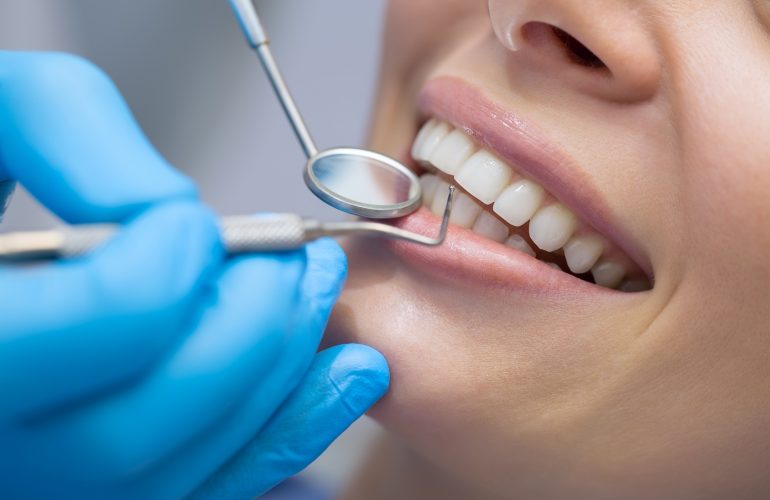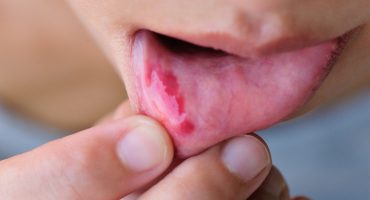By nature, the tooth is optimally protected by the enamel and gums. If, however, the gums retract and the tooth enamel is attacked, the sensitive part of the tooth is exposed. The result: sensitive teeth that react immediately to heat, cold and pressure with toothache. In this case, pain-sensitive teeth can be easily avoided by good oral hygiene. If they are already suffering from sensitive teeth, a walk to the dentist is inevitable, because only he can find the right treatment method to restore a healthy tooth.
What are sensitive teeth?
Eating sweet, sour or hot foods can be quite a disagreeable experience. If the gums retract or the tooth enamel is damaged, the dentinal tubules present in each tooth are exposed. It creates a direct connection from the outside into the dental pulp. Cold, heat and sweetness irritate the pulmonary nerve of the tooth and pain develops.
When you look at a tooth, you only see the enamel at first. The fact that this is only on the upper side of the tooth and not on the tooth neck, which is covered by the gums, is continued, is not clear to most people. If the gums retract and the neck of the tooth is clear, the external protection of the tooth in this region is lost. The tooth nerve, though tightly closed in the pulp and invisible, is now vulnerable to external attack. Even the smallest stimulus can trigger pain.
If the enamel is e.g. attacked by tooth decay and damaged, the tooth quickly loses its protective shell. The result is the same: heat and cold are led unhindered through the tiny dentinal tubules into the tooth, the tooth nerve is irritated and it causes pain.

Causes of sensitive teeth
There are several causes for the decline of gums and the destruction of tooth enamel, which are the main cause of sensitive teeth. First, consider the non-inflammatory origins, as these are the most common cause of sensitive teeth, but they are also easiest to treat and eliminate.
One of the most serious causes of sensitive teeth is the wrong tooth brushing technique. The toothbrush is pressed too hard and the teeth are scrubbed with scrubbing movements. As a result, the gums are exposed to a strong mechanical friction for which it was not created. The gums in these cases have so-called traumatic lesions, that is, injuries that are not caused by inflammation. It creates small wounds, the necks are exposed through them and the teeth hurt sensitive. Also, the enamel can suffer massive damage through this false cleaning technique, the result is the same: the teeth are sensitive, it causes pain.
In children and adolescents, there is often another trigger for sensitive teeth, which is not due to improper cleaning techniques or inflammation and injury in the oral cavity: the fixed braces. The purpose of orthodontic treatment is to put crooked teeth in the correct position. As a result, they are mechanically displaced, which for the most part brings with it a displacement of the tooth from the actual, natural tooth compartment. This in turn means that the tooth is no longer covered with enough jawbone at one point and only a very thin, elongated layer of gum maintains the actual connection between the cervix and the jawbone. In this case, the cervicals are exposed quickly and any contact with heat, cold, sweet or sour hurts.
But even wrong nutrition can lead to an ever thinner enamel layer. If the main acidic drinks and foods are consumed, then the enamel contained in them can attack the enamel. Over time, it becomes thinner and thinner until it finally decomposes completely and the tooth is no longer sufficiently protected.
Inflammatory changes in the oral cavity, which can also be the cause of sensitive teeth, should also not be forgotten. Diseases such as tooth decay, gingivitis or periodontitis, which also attack and destroy the enamel or gums, all have a common cause: bad or bad oral hygiene. If plaque and tartar accumulate on the teeth and if it is not removed regularly and correctly, the caries is not far away. It attacks the enamel, and sensitive teeth will not be long in coming. If the gums are inflamed, caused by gingivitis or periodontitis, the gums do not have to retract significantly or completely disappear to cause sensitive teeth. Inflammation causes the gums to swell and easily lift off the tooth, i.e. the dentinal tubules on the neck of the tooth are now freely accessible for external influences. Pain in heat or cold are the result.
Symptoms of Sensitive Teeth
The symptoms of sensitive teeth are always the same: when drinking and eating hot and cold food and drinks immediately a pulling toothache. It does not last long, but disappears immediately. This short, pulling pain is a so-called irritant pain. Through the exposed dentinal tubules a connection between the outer tooth layer and the inner life of the tooth, the tooth pulp, has been established. In it runs the tooth nerve, which reacts very sensitively to stimuli of all kinds. When cold or heat hits the tooth nerve, it reacts with a warning signal to the body to signal that something is wrong. The tooth hurts. When the external stimulus flow stops on the tooth nerve, it stops sending warning signals and the pain disappears as suddenly as it has come.

Diagnosis of Sensitive Teeth
The body always sends a painful stimulus if it wants to tell us that something is not what it should be. So if you have a toothache unexpectedly, this is a sign that something is wrong with your teeth or the periodontium. Sensitive teeth in themselves are not a disease in the classical sense, but only a symptom with which the body wants to tell us that we should take better care of our teeth. So you should not take sensitive teeth lightly, but get to the bottom of the causes. And this is best done during a visit to the dentist.
The dentist will first take a medical history, that is, he will ask you what pain is occurring, when, and for how long. Only then will he look directly at the bit. Normally, the gum protrudes about 0.5 to 1mm beyond the enamel border, so the tooth should be well protected. With a special instrument, the dentist can measure whether this is actually the case or whether the gum has already come so far away from the cervix or even already gone back that the unprotected tooth neck is exposed. With the naked eye, one can not know whether the tooth neck is still covered by tooth enamel or not. This measurement is similar to the depth measurement of the tooth pockets in the prevention of periodontitis, because ultimately both measurements want to know the same thing: has the gum already detached from the tooth and is the tooth neck free and if so, how far? Of course, the dentist also notes whether the gums are red and swollen, which may indicate inflammation such as gingivitis or even periodontitis. Possible mechanical injuries of the gums, e.g. by incorrect cleaning are also noted.
Of course, the dentist must not forget the enamel. He will examine each tooth for small, white spots on the surface, the first signs of tooth decay from caries. With the help of a small probe, he checks whether the tooth surface has already begun to decompose and soften. If this is the case, the dentinal tubules are already free and the teeth are sensitive to stimuli.
Lastly, he is suspected of present diseases such. Tooth decay, of course, make a thorough diagnosis in this regard, because a treatment of these diseases often leads to the disappearance of sensitive teeth without these need to be treated extra.
Therapy of Sensitive Teeth
Before sensitive teeth can be treated, the causes must first be investigated. If, for example, In addition, an inflammatory change of the gums before, so this must be treated first, before even thinking about a treatment of sensitive teeth. Often the sensitive teeth disappear even when an already existing disease such as gingivitis has been successfully treated. The dentist will first get an overall picture of the oral cavity in order to find the right therapeutic approach.

The right brushing technique for sensitive teeth
If the sensitive teeth are due to a wrong cleaning technique, then the dentist will tell you how to brush the teeth properly. He will also show you which toothbrush is best for you and recommend a special toothpaste and possibly a mouthwash for sensitive teeth. Both help in reminalizing the enamel, i. In the regeneration of the natural protective layer of the tooth and not only treat sensitive teeth, but of course also prevent them.
Tooth seal on sensitive teeth
If only the tooth enamel is attacked, but there is still no caries, it is advisable to seal the sensitive teeth. Probably the simplest method in this case is the application of a special fluoride varnish. He is carefully brushed on the tooth and not only closes the dentinal tubulus (and thus prevents the direct connection to the pulp) but also helps by the contained fluoride in the remineralization of the enamel.
In cases with particularly deep furrows, such as are most commonly found in molars, and when the enamel is already severely worn mechanically (e.g., by teeth grinding), a special plastic filler is used. Today, these plastics are additionally mixed with fluorides, which additionally serves caries prophylaxis. It is believed that a dental seal usually holds between fifteen and twenty years. However, this should not be a pass for bad oral hygiene, because a seal protects only a small part of the teeth, which is often difficult for the toothbrush to access.
Especially with children, this type of dental sealing of permanent teeth is already recommended as a prophylactic when breaking the molars, as their oral hygiene is often not sufficiently guaranteed and in the furrows quickly caries can arise. The statutory health insurance generally undertakes the sealing of up to eight molars in children and adolescents under the age of 18 years. Even if the costs are covered, a prophylactic sealing of teeth is not always useful. You should discuss this individually with the dentist.
Surgical intervention on sensitive teeth
If the necks are already free, the treatment of sensitive teeth is a bit more complicated. The dentist will recommend a cervical filling first. Here, preference is given to using special plastics which meet the high demands on these areas in the mouth. With them, the resulting cavities between the tooth neck and gum are filled and thus sealed the dentinal tubules. However, if the gums have already declined, this method leads visually to very long necks of teeth, which is often considered unsatisfactory for the patient. Aesthetically, this is achieved by a coloring of the lower part of the filling, which is adapted to the color of the gums. However, this solves only a part of the problem, namely the sealing of the cervix, but not the decline of the gum.
In order to counteract the decline of the gums, surgery must be inevitably intervened. The gums are surgically moved toward the cervical neck to cover the exposed areas. The less pronounced the gum retraction, the more successful the treatment, of course, because the gums can only be stretched and stretched conditionally. This surgical procedure has the advantage that the result is optically far more appealing than the filling therapy. In cases of severe gum decline, the use of self-tissue transplantation from other areas of the mouth is now also used. However, this method is not only costly, but also time consuming and painful. That's why you should not let it get that far, but go to the dentist early for dental problems.
Of course, all of these therapies are only used if there are no other subliminal diseases. If sensitive teeth are due to caries, gingivitis or periodontitis, then the dentist will first suggest and perform a therapeutic approach to treating those same conditions. If they still suffer from sensitive teeth after successful therapy, then their dentist will advise you to use one of the above mentioned therapeutic approaches.
Weitere Beiträge

Caries (Tooth decay)
Tooth decay is the dental most common disease in industrialized countries. The term caries is derived from the Latin term caries and means putrefaction or rottenness. Dental caries (Caries dentium) is an infectious infection that can be transmitted from one person to another.



